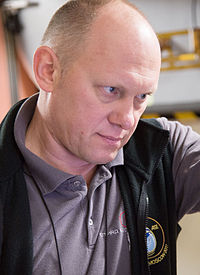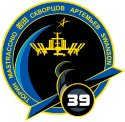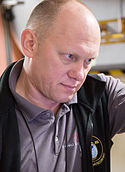Oleg Germanowitsch Artemjew
| Oleg Artemjew | |
|---|---|
 | |
| Land | Russland |
| Organisation | Roskosmos |
| ausgewählt | 29. Mai 2003 |
| Einsätze | 3 Raumflüge |
| Start des ersten Raumflugs | 25. März 2014 |
| Landung des letzten Raumflugs | 29. September 2022 |
| Zeit im Weltraum | 560d 18h 06min |
| EVA-Einsätze | 5 |
| EVA-Gesamtdauer | 34h 39min |
| Raumflüge | |
Oleg Germanowitsch Artemjew (russisch Олег Германович Артемьев; * 28. Dezember 1970 in Riga, Lettische SSR, UdSSR) ist ein russischer Kosmonaut.
Ausbildung
Bis 1990 studierte Artemjew am Polytechnikum in Tallinn. 1998 machte er seinen Abschluss an der Staatlichen Technischen Universität in Moskau.[1]
Kosmonautentätigkeit
Ausbildung
Artemjew wurde als Mitglied der 15. RKK-Energija-Auswahlgruppe am 29. Mai 2003 ausgewählt.[2] Seine Kosmonautengrundausbildung schloss er am 28. Juni 2005 ab.
Für den Flug von Sojus TMA-10M war er in der Ersatzmannschaft eingeteilt.
Sojus TMA-12M – ISS-Expeditionen 39/40

Artemjew nahm als Bordingenieur an den ISS-Expeditionen 39 und 40 zur Internationalen Raumstation teil. Das Raumschiff Sojus TMA-12M startete am 25. März 2014, die Kopplung konnte wegen Problemen mit der Raumschiffsteuerung nicht wie vorgesehen nach knapp sechs Stunden durchgeführt werden, sondern erfolgte erst zwei Tage später am 27. März.[3] Am 11. September 2014 erfolgte die Rückkehr zur Erde. Im Februar 2016 wurde ihm der Titel Held der Russischen Föderation verliehen.[4]
Sojus MS-08 – ISS-Expeditionen 55/56

Mit dem Raumschiff Sojus MS-08 startete Artemjew am 21. März 2018 zu seiner zweiten Mission als Bordingenieur der ISS-Expeditionen 55 und 56. Am 15. August montierte er zusammen mit seinem Kollegen Prokopjew, bei einem mehrstündigen Außenbordeinsatz auf der ISS, die ICARUS-Antenne. Die Rückkehr zur Erde erfolgte am 4. Oktober 2018.
Sojus MS-21 – ISS-Expeditionen 66/67
Start
Artemjew startete als Kommandant der Sojus MS-21 zusammen mit Denis Matwejew und Sergei Wladimirowitsch Korsakow am 18. März 2022 um 15:55:18 UTC. Am 18. März um 19:12:06 UTC dockte das Raumschiff erfolgreich im manuellen Modus an das Pritschal-Knotenmodul des russischen ISS-Segments an.[5] Es war die erste Sojus-Mission zur ISS, die ausschließlich russische Kosmonauten an Bord hatte.[6]
Beim Andocken von Sojus MS-21 lief auf der ISS die ISS-Expedition 66, Kommandant war Anton Nikolajewitsch Schkaplerow. Mit dem Abdocken von Sojus MS-19 am 30. März 2022, 7:21 UTC endete ISS-Expedition 66 und ISS-Expedition 67 begann. Das Kommando übernahm Thomas Marshburn.[7]
Außenbordeinsätze
Nach einer Serie von Außenbordeinsätzen im April 2022 soll der Europäische Roboterarm (ERA) in Betrieb genommen werden. Dabei brachten Oleg Artemjew und sein Kollege Denis Matwejew zunächst bei einem Einsatz am 18. April ein externes Steuermodul an, lösten Schutzabdeckungen und befestigten Haltegriffe. Artemjews vierter Außenbordeinsatz begann um 15:00 UTC und endete nach sechs Stunden und 37 Minuten um 21:37 UTC. Es war der 249. Außenbordeinsatz insgesamt auf der ISS und der 52. Ausstieg aus dem russischen Segment, daher trug er die Bezeichnung RS VKD #52. Artemjew trug dabei den Orlan-MKS Raumanzug Nummer 5 mit roten Streifen zur Identifikation.[8] Bei einem weiteren Ausstieg am 28. April (RS VKD #53) führten Artemjew und Matwejew weitere Schritte zur Inbetriebnahme von ERA durch. Dieser Ausstieg, Artemjews fünfter, dauerte 7 Stunden und 42 Minuten.[9]
Rückkehr zur Erde
Die Rückkehr zur Erde erfolgte am 29. September 2022. Nach drei Langzeiteinsätzen mit 560 Tagen im All liegt Artjemjew auf Platz 12 der Rangliste der erfahrensten Raumfahrer.[10]
Politik
Bei der Wahl 2019 wurde er zum Mitglied der Moskauer Stadtduma gewählt. Er gehört der Fraktion von Einiges Russland an.[11]
Auszeichnungen
- Ehrenbürger von Gagarin (2015)
- Ehrenbürger von Baikonur (2015)
- Held der Russischen Föderation (2016)
- Ehrenbürger von Sneschinsk (2018)
- Verdienstorden für das Vaterland (2020)[11]
Weblinks
- Homepage von Oleg Artemyev (russisch/englisch)
- Kurzbiografie von Oleg Germanowitsch Artemjew bei spacefacts.de
- Twitter von Oleg Artemyev @OlegMKS
- Instagram von Oleg Artemyev
Siehe auch
Einzelnachweise
- ↑ Oleg Germanowitsch Artemjew in der Encyclopedia Astronautica, abgerufen am 4. März 2014 (englisch).
- ↑ Kosmonautenbiographie: Oleg Artjomjew. spacefacts.de, abgerufen am 4. März 2014.
- ↑ Günther Glatzel: Sojus-TMA 12M an ISS gekoppelt. raumfahrer.net, 28. März 2014, abgerufen am 28. März 2014.
- ↑ Erlass des Präsidenten der Russischen Föderation N 59 vom 15. Februar 2016 „Über die Auszeichnung mit den staatlichen Auszeichnungen der Russischen Föderation“ (russisch)
- ↑ Denis Vladimirovich Matveev. In: Astronaut.ru. 19. April 2022, abgerufen am 19. April 2022 (russisch).
- ↑ Chris Gebhardt: First all-Roscosmos cosmonaut mission arrives at station. In: NASASpaceFlight.com. 18. März 2022, abgerufen am 19. April 2022 (amerikanisches Englisch).
- ↑ Jeff Foust: Soyuz returns astronaut and cosmonauts from space station. In: Spacenews.com. Spacenews, 30. März 2022, abgerufen am 19. April 2022 (amerikanisches Englisch).
- ↑ William Graham: Cosmonauts complete spacewalk to activate space station’s European Robotic Arm. In: NASASpaceFlight.com. Nasaspaceflight, 18. April 2022, abgerufen am 19. April 2022 (amerikanisches Englisch).
- ↑ Joseph Navin: Russian cosmonauts conduct second spacewalk to activate European Robotic Arm. nasaspaceflight.com, 28. April 2022, abgerufen am 30. April 2022 (englisch).
- ↑ Astronauten und Kosmonauten (geordnet nach "Gesamtflugzeit"). In: Spacefacts. 29. September 2022, abgerufen am 1. Oktober 2022.
- ↑ a b Артемьев, Олег Германович. In: TASS. Abgerufen am 11. April 2023 (russisch).
| Personendaten | |
|---|---|
| NAME | Artemjew, Oleg Germanowitsch |
| ALTERNATIVNAMEN | Артемьев, Олег Германович (russisch) |
| KURZBESCHREIBUNG | russischer Kosmonaut |
| GEBURTSDATUM | 28. Dezember 1970 |
| GEBURTSORT | Riga, Lettische SSR, UdSSR |
Auf dieser Seite verwendete Medien
Russian cosmonaut Oleg Artemyev, Expedition 40 flight engineer, attired in a Russian Orlan spacesuit, participates in a session of extravehicular activity (EVA) in support of science and maintenance on the International Space Station. During the five-hour, 11-minute spacewalk, Artemyev and Alexander Skvortsov (out of frame) deployed a small science satellite, retrieved and installed experiment packages and inspected components on the exterior of the orbital laboratory.
The International Space Station (ISS) Expedition 67 crew includes NASA astronauts Tom Marshburn, Raja Chari, Kayla Baron, Kjell Lindgren, Bob Hines and Jessica Watkins; Roscosmos cosmonauts Oleg Artemyev, Denis Matveev and Sergey Korsakov; and European Space Agency (ESA) astronauts Matthias Maurer and Samantha Cristoforetti.
- The Expedition 67 patch celebrates our on-going international mission to conduct science and research to improve life on Earth and extend our presence in the solar system.
- The International Space Station (ISS) is poised in the foreground to recognize the contributions of the thousands of engineers, scientists, researchers, trainers, fabricators, leaders, and dreamers who have made this miracle of engineering and sustained operations possible.
- Our beautiful home, the planet Earth, serves as a central element of the patch, just as it is central to the ISS’s mission. While we endeavor to unlock the mysteries of the universe, we are also committed to better understanding the Earth and how we can protect it for future generations.
- Three stars shine bright on a field of black, representing the United States, Russia, and Italy, the three countries with crewmembers on this particular expedition. The numerous stars further scattered across the night sky represent the additional countries that comprise the ISS partnership.
- The life-giving rays of the sun represent our crew’s families, whose love and support make this endeavor possible.
Cosmonaut Oleg Artemyev works on space station hardware at the end of his workday.
ISS Expedition 39 Patch
Increment 39 of the International Space Station Program marks the 15th year of operation since the start of the space laboratory assembly. Today, the U.S., Russia, Japan, Canada and the European Space Agency are partnering in the operation of the largest ever orbital outpost managed by humankind. The names of the six crew members are depicted in their native languages. For Expedition 39, the Soyuz spacecraft serves as transport vehicle for the crew members to and from the station. During this expedition, the ISS will serve as a platform for scientific research, Earth and astronomical observation, education, as well as a stage for the development of new technologies used for the exploration beyond low Earth orbit. The star above the complex signifies human space exploration towards new frontiers. The crew members added these words: "The crew of Expedition 39 is proud to serve the international community in furthering our scientific knowledge and in expanding human presence in space."
Russian cosmonaut Oleg Artemyev, Expedition 39/40 flight engineer, participates in a routine operations training session in an International Space Station mock-up/trainer in the Space Vehicle Mock-up Facility at NASA's Johnson Space Center.
The Expedition 40 patch depicts the past, present, and future of human space exploration. The crew wrote the description that follows: The reliable and proven Soyuz, our ride to the International Space Station (ISS), is a part of the past, present, and future. The ISS is the culmination of an enormous effort by many countries partnering to produce a first-class orbiting laboratory, and its image represents the current state of space exploration. The ISS is immensely significant to us as our home away from home and our oasis in the sky. The commercial cargo vehicle is also part of the current human space exploration and is a link to the future. A blend of legacy and future technologies is being used to create the next spacecrafts which will carry humans from our planet to destinations beyond. The sun on Earth's horizon represents the new achievements and technologies that will come about due to our continued effort in space exploration.
The Expedition 56 crew insignia
- The Expedition 56 astronaut crew will continue the international collaborative work that has been evolving on the International Space Station during the past 17 years. The expedition comes at a time when private corporations and the governments around the world are rapidly developing crew capabilities for human space exploration. Together, with the experience and continued research on the orbiting laboratory, humans will soon establish a new presence in space beyond low-Earth orbit that will enable us to travel farther into space than ever before.
- The Expedition 56 patch portrays a dove carrying an olive branch on its beak. The patch includes images of the Soyuz launch vehicle for the crew and the space station. The Expedition 56 astronauts’ names are displayed on the dove’s wings and along the limb of Earth at the base of the patch.
- The dove's tail is firmly planted on Earth to represent the strong link between our home planet and the humans who are sent into the cosmos. The patch illustrates our hope for peace and love in the world, and the innate human desire to spread our wings and explore into the future, building on the wisdom of the past, for the betterment of humanity. The patch was designed by astronaut Drew Feustel's son.
The official mission insignia of the Expedition 55 crew.
- The six crew members of Expedition 55 are patriots from three different countries – Japan, Russia, and the United States. The crew from these three countries will work together to ensure the success of Expedition 55.
- The three rings symbolize the three countries of the six crew members. The rings join in a common intersection, symbolizing collaboration and a common focus for the crew aboard the space station. The colors of the rings represent the energy and power required to carry humans and equipment into space and to operate the ISS. The colors blue and green represent the magnificent beauty of Earth. The color black represents the darkness of space, and the immense challenge of exploring space. The six stars represent the crew, Norishige Kanai, Scott Tingle, Anton Shkaplerov, A.J. (Drew) Feustel, Oleg Artemyev, and Ricky Arnold. The three flags are the flags representing each crew member’s country. The swoosh extending upward towards space represents the dedication of cosmonauts, astronauts and a multinational support team working together to explore space and discover new science that will benefit all humans.







